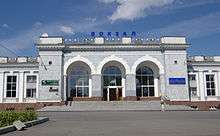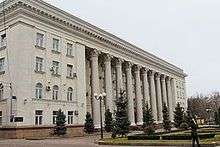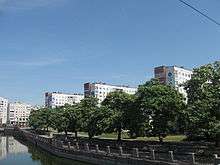Kirovohrad
| Kirovohrad (Кіровоград) Kirovograd (Кировогра́д) | |||
|---|---|---|---|
| City of regional significance | |||
|
Inhul River in Kirovohrad | |||
| |||
| Nickname(s): Little Paris (used in historical context) | |||
| Motto: With peace and goodness | |||
 Kirovohrad (Кіровоград) Location of Kirovohrad Oblast | |||
 Kirovohrad (Кіровоград) | |||
| Coordinates: 48°30′0″N 32°16′0″E / 48.50000°N 32.26667°ECoordinates: 48°30′0″N 32°16′0″E / 48.50000°N 32.26667°E | |||
| Country Oblast Raion |
Ukraine Kirovohrad Oblast City municipality | ||
| Founded | 1754 | ||
| City rights | 1765, 1782 | ||
| Government | |||
| • Mayor | Oleksandr Sainsus[1] | ||
| Area | |||
| • City of regional significance | 103 km2 (40 sq mi) | ||
| Elevation | 124 m (407 ft) | ||
| Population (2013) | |||
| • City of regional significance | 234,322 | ||
| • Density | 2,300/km2 (5,900/sq mi) | ||
| • Metro | 242,919 | ||
| Postal code | 25000-490 | ||
| Area code(s) | +380 522 | ||
| Sister cities | Dobrich | ||
| Website | http://www.kr-rada.gov.ua/ | ||
Kirovohrad (Ukrainian: Кіровогра́д, [kirowɔˈɦrɑd]; Russian: Кировогра́д, Kirovograd), formerly Yelisavetgrad, is a city in central Ukraine located on the Inhul river, and is the administrative center of the Kirovohrad Oblast. Population: 234,322 (2013 est.)[2].
The city is the birthplace of noted figures such as Grigory Zinoviev, Volodymyr Vynnychenko, Arseny Tarkovsky, African Spir and others.
Administrative status
Today Kirovohrad is a city of oblast significance with 244,000 inhabitants. It is divided into two districts — Kirovsky and Leninsky. The urban-type settlement of Nove is part of the Kirovsky district. Kirovohrad serves as the administrative center of Kirovohrad Raion, though administratively it does not belong to the raion.
Name origin
Over its history, Kirovohrad has changed its name several times. Presenting a letter of grant on January 11, 1752 to Major-General Jovan Horvat, the organizer of Nova Serbia settlements, the Empress Elizabeth of Russia ordered "to found an earthen fortress and name it Fort St. Elizabeth" (see On the Historical Meaning of the Name Elizabeth for Our City) (in Ukrainian). Thus simultaneously the future city was named in honour of its formal founder, the Russian empress, and also in honor of her heavenly patroness, St. Elizabeth.
The name Yelisavetgrad (usually spelled Elisavetgrad or Elizabethgrad in English language publications) is believed to have evolved as the amalgamation of the fortress name and the common Eastern Slavonic element "-grad" (Old/Church Slavonic "градъ", "a settlement encompassed by a wall"). Its first documented usage dates back to 1764, when Yelisavetgrad Province was organized together with the Yelisavetgrad Lancer Regiment.
Following the Russian Revolution and founding of the Soviet Union, in 1924 the city was enamed Zinovievsk, (also spelled Zinovyevsk), after Grigory Zinoviev, a Soviet statesman and one of the leaders of the Russian Communist Party (Bolsheviks). He was born in Yelisavetgrad on September 20 (September 8 O.S.), 1883. At the time he was honored by the name, he was a member of the Politburo and the Chairman of the Comintern's Executive Committee.
On December 27, 1934, after the assassination of Sergei Kirov, Zinovievsk and other Soviet cities was renamed again - this time as Kirovo, and then as Kirovograd. The latter name appeared simultaneously with the creation of Kirovograd Oblast, on January 10, 1939 and was aimed at differentiating the region from Kirov Oblast in present-day Russia.
After Ukraine regained independence, the name of the city started to be spelled according to Ukrainian pronunciation as Kirovohrad. The previous Russified orthography is still widely used due to the widespread use of the Russian language in the region.
Since 1991 numerous discussions have been held on the city's name. A number of activists support returning the city to its original name, Yelisavetgrad (or now Yelysavethrad in Ukrainian transcription). Other suggestions for contemporary Ukraine include Tobilevychi (in honour of the Tobilevych family, the Coryphaei of the classic Ukrainian drama established in Kirovohrad in 1882); Zlatopil, from Ukrainian "золоте поле", literally "golden field"; and Stepohrad, Ukrainian for "city of steppes" (in recognition of the agricultural status of the city); Ukrayinsk or Ukrayinoslav, i.e. "the glorifying Ukraine one;" and Novokozachyn (to commemorate the semi-fabulous Cossack regiment which could have been quartered at the present-day city location).
Due to the disagreements and primarily because of the annual city budget deficit, the question of whether to rename Kirovohrad remains unresolved. It would require expenses to change street signs and many other instances of name use.
The President of Ukraine, Petro Poroshenko, signed the bill banning Communist symbols on May 15, 2015, which requires places associated with communism to be renamed within a six-month period.[3] On 25 October 2015 (during local elections) 76.6% of the Kirovohrad voters voted for renaming the city to Yelisavetgrad.[4] A draft law currently before the Ukrainian parliament would prohibit any names associated with Russian history since the 14th century, which would make the name Yelisavetgrad inadmissible as well.[5] A committee of the Verkhovna Rada of Ukraine chose the name Inhulsk on 23 December 2015. The new name is a reference to the nearby Inhul river.[6]
History



Developed around a military settlement, the city rose to prominence in the 19th century when it became an important trade centre, as well as a Ukrainian cultural leader with the first professional theatrical company in either Central or Eastern Ukraine being established here in 1882.
The history of the city foundation dates back to the year 1754 when St. Elizabeth’s fortress was built on the lands of former Zaporizka Sich in the upper course of the Inhul, Suhokleya and Biyanka Rivers. The historic name of the city Yelysavethrad was changed to Zinovyevsk in 1924, for Kirovo in 1934. The city was renamed Kirovohrad on the 10th of January, 1939.
The history of Kirovohrad starts from that of Fort St. Elizabeth. This fort was built in 1754 by the order of empress Elizabeth of Russia and it played a pivotal role in the new lands added to Russia by the Belgrad Peace Treaty of 1739. In 1764 the settlement received status of the center of the Elizabeth province, and in 1784 the status of chief town of a district, when it was renamed after the fort as Yelizavetgrad.
Fort St. Elizabeth was located on the crossroads of trade routes, and it eventually became a major trade center. The city has held regular fairs four times a year. Merchants from all over the Russian Empire have visited these fairs. Also, there were numerous foreign merchants, especially from Greece.
Elizabethgrad was ravaged by famine in 1901 and its residents suffered more due to poor government response. The region is extremely fertile. However, a drought in 1892 and poor farming methods which never allowed the soil to recover, prompted a large famine that plagued the region. According to a 1901 New York Times article, the Ministry of the Interior denied that the persistence of famine in the region and blocked non-State charities from bringing aid to the area. The reporter wrote, "The existence of famine was inconvenient at a time when negotiations were pending for foreign loans." The Governor of the Kherson region, Prince Oblonsky, refused to acknowledge this famine. One non-resident and non-State worker entered Elizabethgrad and could provided the New York Times with an eye-witness account.[7] He observed: general and acute destitution; deaths from starvation; widespread typhus (shows poverty), and little to no work to be found in the region.
In 1905 another riot flared, with Christians killing Jews and plundering the Jewish quarter.[8] A contemporary account was reported in the New York Times on December 13, 1905.[9]
The first theatre in Ukraine was built in Kirovohrad. It was founded by M. Kropyvnyts'ky, I. Karpenko-Karyy, M. Zankovets'ka, P. Saksahans'ky and M. Sadovs'ky.
During Soviet rule, the city economy was dominated by such enterprises as Chervona Zirka Agricultural Machinery Plant (which once provided more than 50% of the USSR need in tractor seeders), Hydrosila Hydraulic Units Plant, Radiy Radio Component Plant, Pishmash Typewriter Plant (de facto defunct nowadays) and others.
In World War II Kirovograd was occupied by Nazi Germany from 5 August 1941. It was liberated by Soviet forces on 8 January 1944.
During the Ukrainian presidential election of 2004, the city got the country-wide notoriety because of mass election fraud committed by local authorities. It became known as District 100 (the community number according to Central Elections Committee).
Symbols
Three blue stripes crossed in the middle of the fortress plan symbolize the fortification location at the confluence of the Inhul, Suhukleya and Biyanka rivers. The crimson colour favoured by Cossacks refers to the fortress being situated on the lands of Zaporozky Cossacks. Golden ears together with a golden field on the shield are symbols of the fertile lands and agricultural wealth of the region.
The shield is held by storks, which symbolize happiness, fertility, and love for the native land. The golden tower in the form of a crown expresses that this coat of arms belongs to the regional centre. The motto “With peace and good” placed on the azure stripe emphasizes the same idea. All the details of the flag correlate with the main elements of the shield on the coat of arms of the city.
Historical heritage
.jpg)



.jpg)
.jpg)

.jpg)


From 1878 to 1905 Oleksandr Pashutin was mayor of the city. Under his administration, the city made advances in education and medicine, construction of the water-supply system and several public buildings, introduction of the first tram, and establishing some market places. Yelizavethrad is noted for its architectural quality, with European-type sculpture and old windows. Surviving are a range of classical and modern monuments, Mooresque and Baroque palaces, and buildings that combine Gothic, Rococo and Renaissance motives. A high level of building technology of Yelizavethrad’s masters encourages construction and restoration these days.
The history of Kirovohrad consists of memorable events and biographies of famous people. One of the creators of the unsurpassed modern architectural ensemble of the historical centre of the city of Yelisavethrad, Y. Pauchenko was born and lived here. Such noted architects as A. Dostoyevskyi and O. Lishnevskyi worked here, too. P. Kalnyshevsky fought for the Cossacks’ freedom on these lands, M. Pirohov laid the foundation of field surgery, M. Kutuzov planned his military operations. Kirovohraders listened to the lectures of the outstanding slavist V. Hryhorovych, and inherited the fundamental investigations of the native land carried out by the ethnographer, historian, archeologist V. Yastrebov.
In different periods of time the history of our region was connected with the names of the famous Ukrainian writer, playwright, publicist and statesman V. Vynnychenko, the poet, literary and cultural critic Y. Malanyuk, the physicist-theoretician, the Nobel Prize laureate I. Tamm, the scientist and inventor, one of the creators of the legendary "Katyusha” G. Langeman, the composer Y. Meytus, the pianist and pedagogue G. Neigauz, the artist and painter O. Osmiorkin, the poet and translator A. Tarkovskyi, the public and cultural figure, memoirist, patron of the arts Y. Chykalenko, the composer, pianist, pedagogue, musician and publicist K. Shymanovskyi, Ukrainian writer, dramatist and script-writer Y. Yanovskyi.
Demography
- 85.8% - Ukrainians
- 12.0% - Russians
- 0.5% - Belarusians
- 1.7% - others
Historical dynamic
| 1897[11] | 1926[12] | 1939[13] | 1959[14] | 1989[15] | 2001[15] | |
| Ukrainians | 23,6% | 44,6% | 72,0% | 75,0% | 76,9% | 85,8% |
| Russians | 34,6% | 25,0% | 10,9% | 18,6% | 19,5% | 12,0% |
| Belarusians | 0,1% | 0,2% | 0,4% | 0,8% | 0,8% | 0,5% |
| Moldavians | 0,03% | 0,2% | 0,7% | 0,4% | 0,5% | 0,3% |
| Jews | 37,8% | 27,7% | 14,6% | 4,4% | 1,9% | 0,1% |
Famous people from Kirovohrad
- Irina Belotelkin, artist and fashion designer
- Olesya Dudnik, Soviet gymnast
- Israel Fisanovich, Soviet Navy submarine commander, hero of the Soviet Union
- Grigory Gamarnik, USSR, world champion (Greco-Roman lightweight), world championship silver[16]
- Moses Gomberg, chemist
- Boris Hessen, historian of science
- Andrei Kanchelskis, Russian-Ukrainian footballer
- Zevulun "Zavel" Kwartin, Jewish cantor.
- Jake Marmer, Jewish poet best known for Umtza, an avant-garde take on Passover.
- Heinrich Neuhaus, Soviet pianist and pedagogue of German extraction
- Victor Orly, French painter, born in Kirovohrad.
- Maurice Podoloff, American Hockey League and National Basketball Association pioneer/executive
- Valeriy Porkujan, Soviet footballer
- Andriy Rusol, football player
- African Spir (or Afrikan Spir), philosopher
- Alexei Suetin, Soviet-Russian International Grandmaster of chess and author
- Arseny Tarkovsky, Russian poet
- John Wegner (1887–1976), artist
- Grigory Zinoviev, Bolshevik revolutionary and a Soviet Communist politician
- Aaron Bodansky, biochemist
Climate
Kirovohrad is located in the central region of Ukraine. Kirovohrad's climate is moderate continental: cold and snowy winters, and hot summers. The seasonal average temperatures are not too cold in winter, not too hot in summer: −4.8 °C (23.4 °F) in January, and 20.7 °C (69.3 °F) in July. The average precipitation is 534 mm (21 in) per year, with the most in June and July.
| Climate data for Kirovohrad, Ukraine (1949-2011) | |||||||||||||
|---|---|---|---|---|---|---|---|---|---|---|---|---|---|
| Month | Jan | Feb | Mar | Apr | May | Jun | Jul | Aug | Sep | Oct | Nov | Dec | Year |
| Record high °C (°F) | 11.1 (52) |
18.7 (65.7) |
22.8 (73) |
28.9 (84) |
36.0 (96.8) |
35.5 (95.9) |
38.1 (100.6) |
39.4 (102.9) |
35.0 (95) |
28.9 (84) |
22.0 (71.6) |
15.7 (60.3) |
39.4 (102.9) |
| Average high °C (°F) | −2.2 (28) |
−1.1 (30) |
4.8 (40.6) |
14.4 (57.9) |
21.0 (69.8) |
24.6 (76.3) |
26.5 (79.7) |
26.1 (79) |
20.5 (68.9) |
13.2 (55.8) |
5.3 (41.5) |
0.1 (32.2) |
12.7 (54.9) |
| Daily mean °C (°F) | −4.8 (23.4) |
−3.9 (25) |
0.8 (33.4) |
9.0 (48.2) |
15.3 (59.5) |
18.8 (65.8) |
20.7 (69.3) |
19.9 (67.8) |
14.6 (58.3) |
8.3 (46.9) |
2.1 (35.8) |
−2.3 (27.9) |
8.2 (46.8) |
| Average low °C (°F) | −7.8 (18) |
−7.1 (19.2) |
−2.8 (27) |
3.8 (38.8) |
9.2 (48.6) |
12.9 (55.2) |
14.7 (58.5) |
13.8 (56.8) |
8.9 (48) |
3.6 (38.5) |
−0.8 (30.6) |
−5.0 (23) |
3.6 (38.5) |
| Record low °C (°F) | −30.0 (−22) |
−31.1 (−24) |
−25.0 (−13) |
−8.0 (17.6) |
−3.6 (25.5) |
0.8 (33.4) |
1.2 (34.2) |
0.0 (32) |
−5.0 (23) |
−10.0 (14) |
−21.2 (−6.2) |
−26.1 (−15) |
−31.1 (−24) |
| Average precipitation mm (inches) | 33.1 (1.303) |
30.7 (1.209) |
33.8 (1.331) |
46.1 (1.815) |
44.0 (1.732) |
70.7 (2.783) |
76.2 (3) |
53.3 (2.098) |
36.4 (1.433) |
28.1 (1.106) |
35.0 (1.378) |
46.7 (1.839) |
534.1 (21.028) |
| Average precipitation days | 20.0 | 17.3 | 15.3 | 7.9 | 9.6 | 8.6 | 5.6 | 4.0 | 7.9 | 10.5 | 15.2 | 18.4 | 140.3 |
| Average relative humidity (%) | 86.3 | 83.8 | 77.1 | 62.2 | 61.6 | 65.9 | 66.8 | 62.4 | 70.5 | 78.2 | 86.8 | 88.5 | 74.2 |
| Source: Climatebase.ru[17] | |||||||||||||
See also
References
- ↑ (Ukrainian) Повага та увага до городян мало коштує, але важить найбільше – мер Кіровограда, Radio Free Europe/Radio Liberty (14 February 2011)
- ↑ "Чисельність наявного населення України (Actual population of Ukraine)" (in Ukrainian). State Statistics Service of Ukraine. Retrieved 21 January 2015.
- ↑ http://en.interfax.com.ua/news/general/265988.html
- ↑ http://en.interfax.com.ua/news/general/299070.html
- ↑ Ukrainian Parliament introduced a bill to ban all Russian geographic names starting from the XIV century
- ↑ "Комитет Рады предлагает переименовать Кировоград в Ингульск, - Вятрович". Censor.
- ↑ "Famine and Disease in South Russia Province" New York Times, 5 Aug. 1901. New York Times. 26 June 2009 .
- ↑ Rosenthal, Herman. Broyde, Isaac. Janovsy, S. Jewish Encyclopedia.com "Yelisavetgrad:Elisavetgrad", accessed June 20, 2009
- ↑ "Russian City Burning; Jews Are Massacred," NY Times, 12 Dec. 1905, accessed 25 June 2009 .
- ↑ 2001 Census reluts
- ↑ The first Russian Empire population census, 1897 year
- ↑ Population census, 1926 year
- ↑ USSR population census, 1939 year.
- ↑ Кабузан В. М. —
- 1 2
- ↑
- ↑ "Climatological Normals for Kirovohrad, Ukraine (1949-2011)". Climatebase. Retrieved April 21, 2013.
External links
| Wikimedia Commons has media related to Kirovograd. |
| Look up kirovohrad in Wiktionary, the free dictionary. |
- Kirovohrad Daily News (Ukrainian)/(Russian)
- Online magazine for young people - "Grechka". News about the cultural life of Kirovograd young people and Kirovohrad region young people.
- Kirovohrad's portal: photos, news, information, etc. (Russian)
- Kirovohrad news, history of the city, photos, science. (Ukrainian)
- Kirovohrad events, history of the city, photos, news and chats with citizen (Ukrainian)
| ||||||||||||||||||||||||||||
| ||||||||||||||||||||||||||
|


